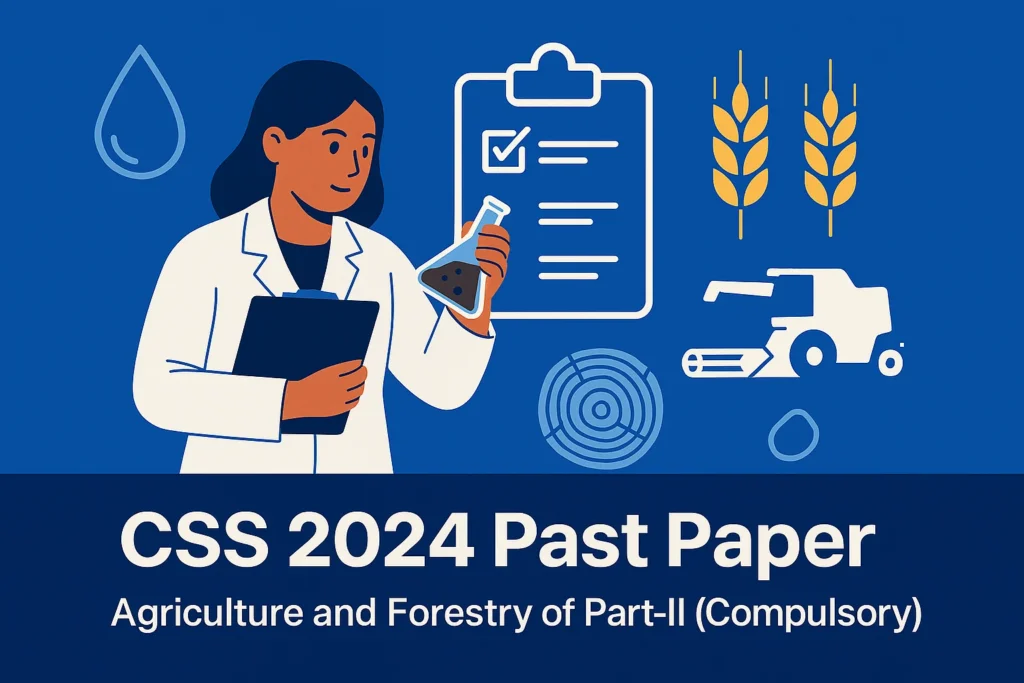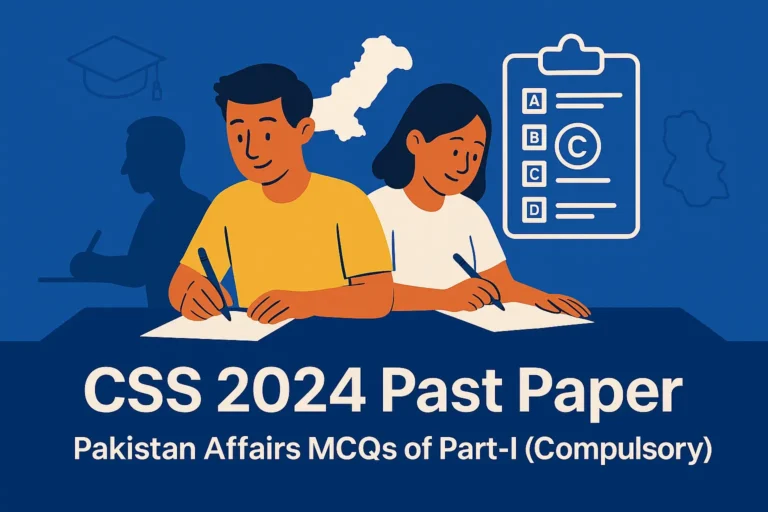CSS Past Paper 2024 Agriculture and Forestry Descriptive (Part 2)

CSS | Past Paper | Group 4 | 2025 | Part 2 | Descriptive
Below is the solution to PART-II (COMPULSORY) of the CSS Past Paper 2024 Agriculture and Forestry Descriptive (Part 2).
Question 2
Explore the present situation of oilseed crops in Pakistan and identify potential factors contributing to the insufficient production of edible oil. Propose remedial measures aimed at enhancing this situation.
Introduction
Oilseed crops are important for food security and economic growth. In Pakistan, edible oil is one of the top imported items, costing billions every year. Even though Pakistan has good climate and soil for oilseed crops, the country still depends heavily on imports. This shows a gap between production and consumption.
Present Situation of Oilseed Crops in Pakistan
- Major Oilseed Crops:
- Sunflower, Canola, Rapeseed-Mustard, Sesame, and Cottonseed.
- Cottonseed is the main source of local edible oil (around 60%).
- Low Local Production:
- Only 20-25% of total demand is fulfilled locally.
- Around 3 million tons of edible oil is imported every year.
- Import Bill:
- Pakistan spends over $4 billion annually on import of edible oil and oilseeds.
- Area Under Cultivation:
- Oilseed crops are cultivated on a limited area.
- Farmers give more importance to wheat, rice, and sugarcane.
Factors Behind Insufficient Production
- Lack of Awareness:
- Farmers are not aware of the importance and benefits of oilseed crops.
- Low Yield Varieties:
- Use of old seeds that give less yield.
- Limited access to hybrid or high-yield varieties.
- Poor Support Price:
- No proper government price or market support.
- Farmers prefer cash crops with better profits.
- Water Issues:
- Oilseed crops need proper irrigation.
- Water scarcity in many areas affects production.
- Lack of Research and Development:
- Less investment in oilseed research.
- Weak link between research institutes and farmers.
- Storage and Processing Problems:
- Poor infrastructure for oil extraction and storage.
Remedial Measures
- High-Yielding Seeds:
- Introduce better quality seeds through research.
- Promote use of hybrid seeds.
- Support Price and Subsidies:
- Announce fixed support price to attract farmers.
- Provide fertilizer and input subsidies.
- Farmer Training and Awareness:
- Conduct awareness programs.
- Demonstrate modern techniques at field level.
- Crop Diversification Policy:
- Reduce area under water-thirsty crops like sugarcane.
- Promote oilseeds in those areas.
- Public-Private Partnership:
- Encourage private sector to invest in oilseed production and processing.
- Expansion of Area Under Cultivation:
- Use uncultivated or barani (rain-fed) lands for oilseeds.
- Better Marketing Channels:
- Ensure good market access and fair prices.
- Use of Modern Technology:
- Promote mechanized farming and drip irrigation.
Conclusion
Pakistan has great potential to become self-sufficient in edible oil. But it requires proper planning, support, and awareness. If government and farmers work together with focus on technology and good policies, oilseed production can increase. This will reduce import bills and help improve the economy.
Question 3
Examine the distinctions between organic farming and conventional farming practices. Analyze the merits and drawbacks of each method. Evaluate factors such as environmental impact, yield, and soil health to provide a comprehensive understanding of the advantages and disadvantages associated with both approaches. Which would you recommend in Pakistan’s perspective?
Introduction
Agriculture is the backbone of Pakistan’s economy. Farmers mostly use conventional farming, but now organic farming is getting attention because of health and environmental concerns. Both methods have different practices, benefits, and problems.
Distinctions Between Organic and Conventional Farming
| Aspect | Organic Farming | Conventional Farming |
| Fertilizers | Natural (compost, manure) | Synthetic (chemical fertilizers) |
| Pesticides | Natural (neem, bio-pesticides) | Chemical pesticides and insecticides |
| GMOs | Not allowed | Allowed |
| Soil Treatment | Natural methods like crop rotation | Chemical-based methods |
| Farming Approach | Eco-friendly, long-term sustainability | Focus on high yield and fast results |
Merits of Organic Farming
- Better Soil Health:
- Organic matter improves soil fertility.
- No chemical damage to soil microbes.
- Environment Friendly:
- Reduces pollution of water and air.
- Protects biodiversity.
- Healthier Food:
- No harmful residues of pesticides in crops.
- Low Input Cost:
- Uses farm waste and natural resources.
Drawbacks of Organic Farming
- Low Yield:
- Produces less compared to conventional methods.
- Time-Consuming:
- Takes more time for crop maturity and soil improvement.
- Pest Attacks:
- Natural pest control methods are sometimes less effective.
- Lack of Awareness:
- Most farmers in Pakistan don’t know organic methods well.
Merits of Conventional Farming
- High Yield:
- Chemicals and GMOs give faster and larger output.
- Efficient and Quick:
- Saves time and increases profit.
- Widespread Use:
- Easily accepted by farmers due to knowledge and machinery.
Drawbacks of Conventional Farming
- Soil Degradation:
- Continuous use of chemicals destroys soil life.
- Health Risks:
- Pesticide residues in food are dangerous for health.
- Water Pollution:
- Chemical runoff pollutes rivers and underground water.
- Dependency on Inputs:
- Farmers rely heavily on market inputs (fertilizers, seeds).
Environmental Impact
- Organic farming protects the environment and reduces global warming effects.
- Conventional farming causes pollution, soil erosion, and loss of biodiversity.
Soil Health Comparison
- Organic methods keep the soil alive and rich.
- Conventional methods give quick results but damage long-term fertility.
Yield Comparison
- Conventional gives more output in short time.
- Organic takes time but improves sustainability.
Recommendation for Pakistan
Pakistan is facing soil fertility loss, water pollution, and health issues due to chemicals. A complete shift to organic farming may not be possible soon, but a mixed approach is better.
Suggested Way Forward
- Promote organic farming in selected areas.
- Train farmers on organic methods.
- Provide subsidies for organic inputs.
- Encourage organic certification and export.
Conclusion
Both farming systems have pros and cons. For a developing country like Pakistan, integrated farming (mix of both) can be more practical. Organic farming is better for the future of agriculture, the environment, and public health, but it needs policy support, education, and investment to succeed.
Question 4
Assess the impact of climate change on Pakistan’s agriculture, particularly its effects on crop patterns and yields. Provide an analytical overview of current practices and propose strategies to make crop management more resilient to climate change, considering adaptation and mitigation measures.
Introduction
Pakistan is an agricultural country, but climate change is putting its food security at risk. Rising temperatures, unpredictable rainfall, floods, and droughts are affecting crops badly. Farmers are facing losses, and the agriculture system is struggling to adjust.
Impact of Climate Change on Agriculture in Pakistan
- Changing Rainfall Patterns:
- Delayed or early monsoons.
- Less rainfall in some areas and heavy floods in others.
- Rising Temperatures:
- Hotter summers reduce wheat and rice yields.
- Some crops fail to mature properly.
- Increased Pests and Diseases:
- Warmer weather helps pests multiply faster.
- Crops face more insect attacks and fungal problems.
- Glacier Melting and Water Shortage:
- Water flow from glaciers is becoming irregular.
- Canals and rivers dry up, causing irrigation problems.
- Extreme Weather Events:
- Droughts, floods, and heatwaves are now more common.
- 2022 floods destroyed millions of acres of crops.
- Impact on Crop Patterns:
- Crops like wheat and maize are shifting to cooler areas.
- Farmers are being forced to change sowing and harvesting times.
Current Practices and Weaknesses
- Over-Dependency on Canal Irrigation:
- Most farmers depend on river water which is getting less reliable.
- Monoculture Cropping System:
- Planting same crops again and again reduces soil health.
- Low Use of Technology:
- Most farmers use traditional methods with no climate-smart tools.
- Limited Awareness:
- Farmers don’t fully understand climate risks and adaptation methods.
- Poor Crop Insurance and Support:
- No proper system to support farmers during climate disasters.
Strategies for Resilient Crop Management
Adaptation Measures:
- Crop Diversification:
- Grow multiple crops to reduce risk from climate shocks.
- Use of Drought and Heat-Resistant Varieties:
- Introduce climate-resilient seeds for wheat, maize, rice, etc.
- Improved Irrigation Techniques:
- Promote drip irrigation and rainwater harvesting.
- Early Warning Systems:
- Weather alerts for farmers to take timely actions.
- Farmer Education:
- Train farmers about climate-smart agriculture.
Mitigation Measures:
- Reduce Chemical Use:
- Adopt organic and natural farming methods to cut emissions.
- Agroforestry:
- Grow trees on farms to improve microclimate and soil.
- Conservation Tillage:
- Minimum plowing keeps carbon in the soil and prevents erosion.
- Carbon Sequestration in Soils:
- Use compost and green manures to trap carbon.
Government Role and Policy Recommendations
- Strong Climate Policy for Agriculture:
- Include agriculture in national climate action plans.
- Crop Insurance Schemes:
- Support farmers financially during floods or droughts.
- Research and Innovation:
- Invest in agriculture universities and climate labs.
- Public-Private Partnership:
- Engage private sector in technology transfer and training.
Conclusion
Climate change is a real threat to Pakistan’s agriculture. It affects crop patterns, yield, and farmer income. But with smart planning, better seeds, modern irrigation, and government support, we can protect our crops and ensure food security. The time to act is now.
Question 5
Write short notes on the following:
a. Conservation and utilization of plant genetic resources
b. Integrated nutrient management
a. Conservation and Utilization of Plant Genetic Resources
Introduction
Plant genetic resources (PGR) are the base of food security and crop improvement. These include seeds, planting material, and wild relatives of crops that hold valuable traits like disease resistance and drought tolerance.
Importance of Conservation
- Biodiversity Protection:
- Conserving PGR helps protect crop diversity, especially native and traditional varieties.
- Future Breeding:
- These resources are used to develop new varieties with better yield and climate tolerance.
- Food Security:
- Diverse genetic material ensures availability of food crops in changing environments.
Types of Conservation
- In-situ Conservation:
- Protecting plants in their natural habitats (e.g., national parks, farmers’ fields).
- Ex-situ Conservation:
- Collecting and storing seeds in gene banks (e.g., National Gene Bank in Pakistan).
Utilization Methods
- Crop Improvement:
- Scientists use wild and local varieties to develop hybrid and resistant crops.
- Biotechnology Tools:
- Use of genetic engineering and tissue culture for better plant development.
- Seed Distribution:
- Making improved and diverse seeds available to farmers.
Challenges
- Lack of awareness, weak policies, and limited gene bank facilities.
Conclusion
Conserving plant genetic resources is critical for sustainable agriculture. Pakistan needs strong efforts to protect local seeds and use them for national food security.
b. Integrated Nutrient Management (INM)
Introduction
Integrated Nutrient Management (INM) is the balanced use of organic, inorganic, and biological sources to provide nutrients to crops. It aims to improve soil health and increase crop yield sustainably.
Components of INM
- Chemical Fertilizers:
- Urea, DAP, and other synthetic fertilizers used in proper amount.
- Organic Manures:
- Farmyard manure (FYM), compost, and green manures enrich soil.
- Biofertilizers:
- Use of bacteria like Rhizobium and Azotobacter that fix nitrogen.
Advantages of INM
- Improves Soil Fertility:
- Restores soil structure, microbes, and organic matter.
- Increases Yield:
- Provides balanced nutrition for better plant growth.
- Reduces Chemical Use:
- Minimizes environmental pollution and cost for farmers.
- Sustainable Farming:
- Maintains productivity for future generations.
Practices in Pakistan
- Most farmers rely only on chemical fertilizers.
- INM is being promoted through government programs and agriculture extension services.
Challenges
- Lack of awareness, poor quality compost, and expensive biofertilizers.
Conclusion
INM is a key solution for sustainable crop production. By combining natural and chemical sources, Pakistan can increase crop yields while saving the environment.
Question 6
How can integrated watershed management address the competing demands for water in agriculture, industry, and domestic use? Analyze the impact of deforestation on watershed health and water availability. How can we integrate science and community engagement in watershed management?
Introduction
Water is life, but in Pakistan, it is getting scarce fast. Agriculture, industry, and cities all need water. Integrated Watershed Management (IWM) is a way to manage land and water together, so everyone can benefit. It helps balance water use while protecting the environment.
What is Integrated Watershed Management (IWM)?
IWM is the coordinated use and protection of water, land, and other resources in a watershed. It involves planning for sustainable water supply, soil conservation, and community needs.
Addressing Competing Demands of Water
- For Agriculture:
- Promote efficient irrigation methods (drip, sprinkler).
- Harvest rainwater and recharge groundwater.
- Build small dams and ponds for storing water.
- For Industry:
- Enforce water recycling and treatment plants.
- Allocate water based on environmental rules.
- For Domestic Use:
- Improve water supply systems in rural and urban areas.
- Reduce leakages and wastage in distribution systems.
- Fair Distribution:
- IWM helps in equitable sharing of water between different users based on need and priority.
Impact of Deforestation on Watershed Health
- Soil Erosion:
- Without trees, topsoil is washed away, reducing water-holding capacity of land.
- Reduced Water Infiltration:
- Tree roots help water goes underground. Deforestation reduces groundwater recharge.
- Flooding and Droughts:
- More floods in rainy seasons and less water in dry periods due to disturbed water cycle.
- Siltation of Rivers and Dams:
- Eroded soil blocks canals and reduces dam life.
Integrating Science in Watershed Management
- GIS and Remote Sensing:
- Use satellite maps to monitor water sources and forest cover.
- Hydrological Modelling:
- Predict rainfall patterns and water flow to plan usage.
- Climate Data Use:
- Adjust farming and water storage according to weather patterns.
- Water Quality Monitoring:
- Science helps check pollution and take quick action.
Community Engagement in Watershed Management
- Village-Level Committees:
- Locals help in planning and maintaining water structures.
- Training and Awareness:
- Teach people about water saving and tree plantation.
- Participation in Decision-Making:
- Community input ensures long-term success.
- Public-Private Partnerships:
- NGOs and private companies can support with money and technology.
Case Example (Pakistan)
In parts of Khyber Pakhtunkhwa and Punjab, small watershed projects with community participation have improved water availability and reduced erosion.
Conclusion
Water demand is growing, and climate change is making things worse. Integrated Watershed Management is the best way to manage water smartly. With science and local people working together, Pakistan can secure water for farming, factories, and families—today and for the future.
Question 7
How effectively does the Pakistan Forest Policy integrate with the provisions outlined in the Pakistan Forest Act? Provide specific examples that how the policy’s strategic goals are translated into actionable legal measures within the act. Discuss any areas where alignment may be strengthened or improved for more coherent forest governance.
Introduction
Forests are key for environment, biodiversity, and climate regulation. In Pakistan, forest area is only around 5%, which is far below the international standard (25%). To manage and protect forests, we have two main tools:
- Pakistan Forest Policy (2015)
- Pakistan Forest Act (1927)
The policy sets national goals, while the act provides legal tools. But there are still gaps in implementation and alignment.
Pakistan Forest Policy – Key Strategic Goals
- Increase Forest Cover:
- Aim to raise forest area from 5% to 8–10% of total land.
- Community Participation:
- Promote joint forest management and community involvement.
- Climate Change Mitigation:
- Use forests for carbon sequestration and adaptation.
- Conservation of Biodiversity:
- Protect wildlife habitats and natural ecosystems.
- Sustainable Forest Management:
- Balance between timber production and forest protection.
- Private Sector Involvement:
- Encourage private tree planting and agroforestry.
Pakistan Forest Act (1927) – Key Legal Provisions
- Reserved and Protected Forests:
- Defines forest areas under legal protection.
- Restrictions on Cutting and Grazing:
- Controls timber harvesting, grazing, and forest land use.
- Offences and Penalties:
- Provides punishment for illegal logging and encroachment.
- Forest Officers’ Powers:
- Allows forest officials to arrest and confiscate illegal timber.
Integration between Policy and Act – With Examples
- Goal: Community Participation
- Policy: Promotes local community engagement.
- Act: Lacks clear legal framework for community-based forest management.
- Example: In KP, joint forest management is done, but legal backing is weak.
- Goal: Climate Change Mitigation
- Policy: Focuses on carbon sinks and REDD+ projects.
- Act: No mention of climate change or carbon trading.
- Gap: Need to update Act to include climate-related legal tools.
- Goal: Forest Expansion
- Policy: Targets large-scale plantation.
- Act: Allows land to be declared as forest, but slow implementation.
- Example: Billion Tree Tsunami in KP used policy direction, but legal support was not fully clear.
- Goal: Biodiversity Conservation
- Policy: Aims to protect rare species and habitats.
- Act: Only protects trees, not full ecosystems.
- Gap: Wildlife and ecosystem protection is not directly covered in the Forest Act.
- Goal: Private Sector Involvement
- Policy: Supports commercial plantation.
- Act: No clear incentives or protection for private growers.
Areas for Improvement and Alignment
- Update the Forest Act (1927):
- It’s over 95 years old. Needs revision to match current policy goals.
- Include Climate and Biodiversity Terms:
- Make law more modern and eco-focused.
- Legalize Community Forest Models:
- Add legal sections for village-level forest committees.
- Promote Technology Use:
- Legal tools for using GIS, drones, and digital monitoring.
- Harmonize Federal and Provincial Laws:
- After 18th Amendment, provinces made their own forest laws. Need better coordination.
Conclusion
Pakistan’s forest policy gives a strong vision, but the forest act is outdated. To make forest governance effective, we must align the policy goals with legal tools. By revising the act and filling the gaps, we can ensure better protection and sustainable use of our limited forest resources.
Question 8
Write short notes on the following:
a. Potential of Ecotourism in Pakistan
b. Biodiversity
a. Potential of Ecotourism in Pakistan
Introduction
Ecotourism means responsible travel to natural areas, focusing on conservation, local culture, and sustainability. Pakistan has great potential for ecotourism due to its mountains, forests, lakes, deserts, and wildlife.
Major Ecotourism Attractions in Pakistan
- Northern Areas:
- Places like Hunza, Skardu, Fairy Meadows, and Deosai are rich in scenic beauty, glaciers, and rare animals.
- Forests and National Parks:
- Margalla Hills, Ayubia National Park, Khunjerab National Park, and Hingol National Park offer wildlife and nature viewing.
- Lakes and Wetlands:
- Saif-ul-Muluk, Attabad Lake, and Haleji Lake are great for nature lovers and birdwatchers.
- Cultural Ecotourism:
- Local tribal cultures, handicrafts, and traditional food attract tourists to remote villages.
Benefits of Ecotourism
- Income for Local People:
Small businesses like guest houses, tour guides, and handicrafts get support. - Environmental Awareness:
Tourists learn to respect nature, and locals work to protect it. - Conservation Funding:
Entry fees and tourism tax can support forest and wildlife protection.
Challenges
- Lack of infrastructure (roads, hotels).
- No proper eco-guidelines or trained staff.
- Littering and pollution due to careless tourism.
Way Forward
- Develop eco-friendly lodges and trails.
- Train local youth as eco-guides.
- Make policies to promote sustainable tourism.
- Involve communities in tourism planning.
Conclusion
With proper planning and investment, ecotourism can help Pakistan boost its economy while protecting nature. It is a win-win for both the environment and people.
b. Biodiversity
Introduction
Biodiversity means the variety of life—plants, animals, and microorganisms—in an ecosystem. It is essential for ecological balance, food security, and climate resilience.
Types of Biodiversity
- Genetic Diversity:
- Variety within species (e.g., different types of wheat).
- Species Diversity:
- Variety of different organisms (e.g., birds, mammals, insects).
- Ecosystem Diversity:
- Different habitats (e.g., forests, wetlands, deserts).
Importance of Biodiversity
- Provides food, medicine, fuel, and raw materials.
- Supports pollination, soil fertility, and water purification.
- Maintains climate balance and prevents disasters like floods.
Threats to Biodiversity in Pakistan
- Deforestation:
- Cutting of trees destroys habitats.
- Pollution:
- Air and water pollution kills aquatic and land species.
- Climate Change:
- Melting glaciers and rising temperatures affect ecosystems.
- Illegal Hunting and Poaching:
- Endangered animals are killed for trade.
Conservation Efforts
- Protected areas and national parks.
- Biodiversity Action Plans by government.
- Community-based conservation projects.
Conclusion
Biodiversity is the lifeline of the planet. Pakistan must take serious steps to conserve its unique plants and animals for future generations. Public awareness and strict implementation of laws are necessary.
📘 Benefits of Practicing This Descriptive Paper
- ✅ These CSS Past Paper 2024 Agriculture and Forestry Descriptive questions are compiled from authentic FPSC CSS past papers, following the real written exam format.
- 💬 Attempting this CSS Past Paper 2024 Agriculture and Forestry Descriptive helps students master structured writing and analytical skills for CSS exams.
- 🧾 Every question in this CSS Past Paper 2024 Agriculture and Forestry Descriptive strictly follows the official CSS exam syllabus approved by FPSC.
- 📊 Students preparing for CSS 2024 can rely on this CSS Past Paper 2024 Agriculture and Forestry Descriptive to practice time management and topic selection.
- 🔍 The solved CSS Past Paper 2024 Agriculture and Forestry Descriptive contains concise explanations to improve conceptual understanding and writing clarity.
- 🎯 Regular revision of this CSS Past Paper 2024 Agriculture and Forestry Descriptive builds confidence and strengthens your preparation for the CSS written paper.
- 🏆 This CSS Past Paper 2024 Agriculture and Forestry Descriptive is essential for mastering exam techniques and achieving success in the FPSC CSS 2024 examination.
🏁 Final Note
Keep revising these CSS Past Paper 2024 Agriculture and Forestry Descriptive to strengthen your grip on important concepts and improve accuracy in upcoming CSS exams. Regular practice with these CSS Past Paper 2024 Agriculture and Forestry Descriptive will help you score higher and build full command over the CSS exam syllabus.
👉 Also read CSS Past Paper 2024 Agriculture and Forestry (Part-I MCQs)
🔗 Check FPSC past papers directly from the official FPSC website.






